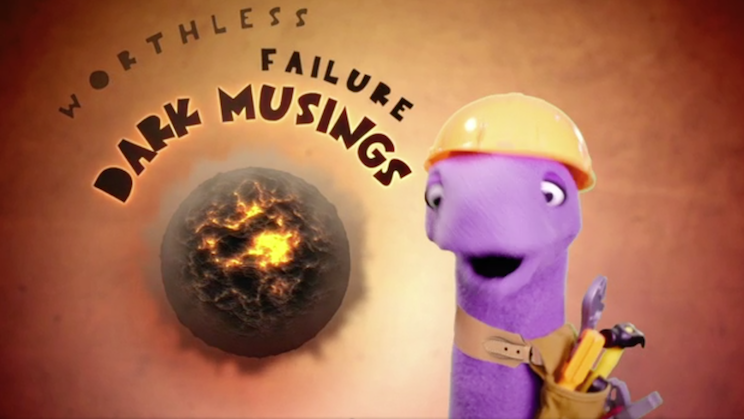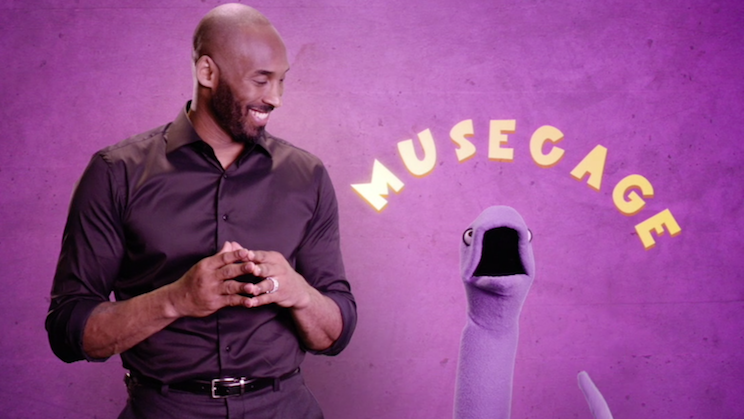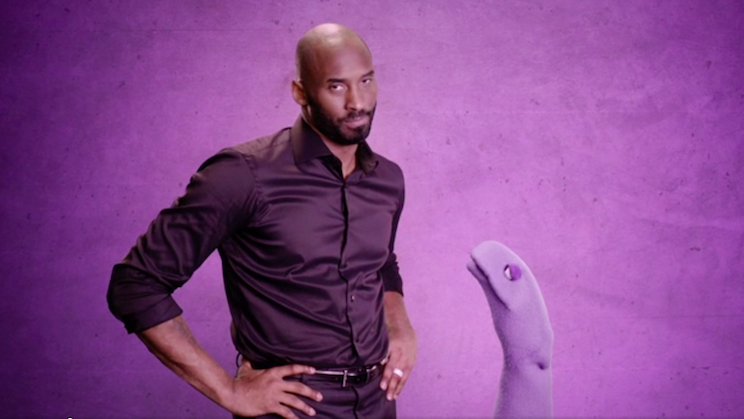Kobe Bryant invited us into a strange world with his talking snake puppet

Kobe Bryant is arguably one of the 10 greatest basketball players ever to grace the planet. That much is well-established. After watching the latest video segment he created for his six-part “Canvas” series on ESPN, I’m not quite ready to declare him one of the 10 greatest filmmakers ever to walk the Earth.
After debuting the first part of that series, “Guarding the Greats,” on Christmas Day — a well done five-minute segment in which he compared Kevin Durant defending LeBron James to Wile E. Coyote’s pursuit of Road Runner — Kobe spent the past few months developing part two of his video project.
[Follow Ball Don’t Lie on social media: Twitter | Instagram | Facebook | Tumblr]
The result — a 10-minute segment called “Canvas City: Musecage” that can be seen here and here — was something much, much weirder. It was basically an extension of his first film endeavor, Showtime’s “Kobe Bryant’s Muse” documentary, which detailed various influences, or musings, that motivated him to be a great player, like the 2008 NBA Finals loss to the Boston Celtics, for example.
Only this time he explained this theory to a snake puppet named “Li’l Mamba” in a fever dream of a clip that seemed straight out of Mister Rogers’ land of make-believe, complete with a toy train running through Canvas City. Here’s how Bryant described his creative process to ESPN.com’s Baxter Holmes:

“The first thing I thought of was ‘Sesame Street,’ ‘Canvas Street,'” Bryant says. “So I wrote a jingle for ‘Canvas Street.’ And I was like, ‘Whoa, no — street?’ It can be bigger: ‘Canvas City.’ We can have different parts of the world — the downtown portion represents something, this represents something. Then once that came to me, then it became very easy for me to start populating the world and the rules of it. The world-building part came pretty quickly once the idea set in.”
I enjoyed hearing the wheels turn in Kobe’s head from “Sesame Street” to “Canvas Street” to — whoa — “Canvas City,” as if this was Francis Ford Coppola bringing “The Godfather” to life. The streets in Canvas City were named Motivation Street and Lazy Street, so yeah, you can see how “it became very easy for me to start populating the world and the rules of it,” since we’re aware of Kobe’s muse theory already.

We arrive at Muse Academy (get it?), where Kobe explains to the snake puppet, “A Musecage is a room decorated with any and everything that inspires you. When you are in a Musecage, you are surrounded by musings that keep you focused and motivated.” So, Kobe basically just described your cubicle.
kobe bryant is talking to a puppet on abc and this molly is very pure and strong
— ☕netw3rk (@netw3rk) March 26, 2017
The snake puppet asks Kobe if a Musecage can make him a beast on the basketball court. The answer: Of course. This is, after all, the point of his video segment, I think. Go in a Musecage, come out a beast — like Russell Westbrook or James Harden, who played against each other on ABC Sunday afternoon.
“Use your curiosity to search all over the world for musings that you can use to decorate your Musecage,” said Bryant. “The more musings you find, the more powerful your Musecage becomes. Every Musecage is powered by two forces — light musings and dark musings. Light musings make you feel good and happy. Dark musings make you feel bad and angry. … Dark musings just might be our greatest source of energy and power. If you’re looking for your inner beast, it’s most likely living inside of a dark muse.”
We then cut to a Fantasia-like cartoon set to a song penned by Bryant with lyrics like, “This is the face of a man with a dark Musecage,” billowing over images of a beast climbing a mountain shaped like the Larry O’Brien trophy. I love that Kobe felt the need to share this idea with the world, because now we know there’s little difference between him and your buddy who dropped one too many tabs of acid.

“The key is to see the potential,” Bryant told Holmes. “When I go into ESPN and say, ‘Well, it’s a puppet and so forth,’ they kind of look at you like, ‘What?’ So when I went in and said, ‘I want 10 minutes,’ They were like, ‘Hold on now. That’s kind of crazy.’ I said, ‘Listen, I have to have these 10 minutes. Trust me.'”
Kobe eventually got around to the subject everybody tuned in to see — actual pregame basketball discussion. After asking the snake puppet who his favorite player was, and the snake puppet saying, “Russell Westbrook and James Harden, not you” (jokes!), we were treated to this Kobe face (acting!):

Kobe then created an imaginary crystal ball, which apparently holds everything there is to learn about sports. Once inside the crystal ball, the voice of Belle from “Beauty and the Beast” narrated Kobe’s thoughts on players reading pick-and-rolls, while Westbrook and Harden highlights played on screen:
“James and Russell can shoot, finish at the rim and find the open man, which makes reading the defense easy. But here’s the question: Are James and Russell simply reading the defense, or are they doing something more? Reading the game will make you a good player, understanding what you are reading will make you a great player, but if you can write the game that others read, you become a champion. Muse on and dominate.”
So deep. So Kobe.
It all ends with the snake puppet turning into a beast, donning Westbrook’s jersey and Harden’s beard, and ranting about how he wants to drop a quintuple-double before Kobe says “Musecage”:
What the hell are we doing here ESPN pic.twitter.com/10SHUqOrIv
— CJ Fogler (@cjzero) March 26, 2017
kobe is speaking to a bearded sperm right now
— ☕netw3rk (@netw3rk) March 26, 2017
A post shared by Kobe Bryant (@kobebryant) on Mar 26, 2017 at 12:30pm PDT
So, there you have it: Kobe spent the past few months recycling his dark muse theory as a Sesame Street and Fantasia knockoff, and now I can’t wait for the final four segments of his “Canvas” series. I liked Kobe’s muse theory. I just liked it better the first time he explained it on his documentary. I don’t know who this one is for, other than Bryant himself playing with the sort of filmmaking ideas many of us had in middle school. That ESPN is paying him to air this strange world of his on TV is the best. I think it’s cool that he’s interested in filmmaking, has bizarre thoughts and is willing to blend the two.
This is the Kazaam that Kobe never had
— Mitch Robson (@_mitchrobson) March 26, 2017
This was how Bryant sold “Musecage” to us in an ESPN press release prior to its airing on Sunday:
“‘Canvas City: Musecage’ helps others better their best by delivering complex basketball insights in a light-hearted, easy-to-digest way. The show helps others understand the game at a higher level and offers a new voice to sports storytelling that will hopefully captivate the whole family.”
I guess Bryant’s breakdown of how Westbrook and Harden read pick-and-rolls was the complex basketball insight we got, but mostly it came across how you might expect from a retired basketball player who spent the lead-up to it sounding like every art student you stopped listening to in college.
“It just makes sense to us,” Bryant told ESPN.com last week. “If you talk to us, everybody that worked on it, it’s like, ‘Well, why wouldn’t we?’ You have an idea and then you go with it and then, [it’s like], ‘Oh, we think we can make it better.’ And you just create. So it wasn’t even a thought that this was risk-taking or anything like that. We just let the art lead us, and where it goes, it goes. …
“If we can inspire every child, every child athlete in the world, and then inspire grownup athletes to find every kid within themselves all over again, then we’re good.”
Mission accomplished. I’m sure every man, woman and child was transformed by this experience.
[Sign up for Yahoo Fantasy Baseball: Get in the game and join a league today]
Bryant wasn’t done there. He joined “NBA Countdown” with Sage Steele and Jalen Rose, who described the video as an “amazing piece” and joked of defending Kobe in his 81-point game, “I was on the wrong side of the Musecage.” The subject of Westbrook and Harden came up again, and sure enough Bryant went off on another Musecage rant, describing Harden’s failure to make the All-NBA team last year and Kevin Durant’s departure to the Golden State Warriors as the dark muses that fueled them:
How was this not in his film called “Musecage” about Westbrook and Durant? I don’t know about you, but I would’ve liked to hear Belle from “Beauty and the Beast” explain how not making All-NBA First or Second Team in 2005 or seeing Shaquille O’Neal go in a 2004 trade fueled Kobe to the 2008 MVP and back-to-back titles in 2009 and 2010. That would be insight you can’t get from anyone else but one of the best basketball players of all-time. I can get pick-and-roll coverage breakdowns everywhere.
Rose and Steele then posed the biggest question of the NBA season to Bryant: Who should win the MVP — Westbrook or Harden? To which Kobe responded, “It’s tough, man. It doesn’t really make any sense to me. It’s hard to really come up with a rational decision of who should be MVP, so it’s tough. We might see our first co-MVPs this year.” You just can’t get great basketball talk like that anywhere.
Now excuse me while I go add “Canvas City: Musecage” as a dark muse in my Musecage.
– – – – – – –
Ben Rohrbach is a contributor for Ball Don’t Lie and Shutdown Corner on Yahoo Sports. Have a tip? Email him at rohrbach_ben@yahoo.com or follow him on Twitter! Follow @brohrbach



